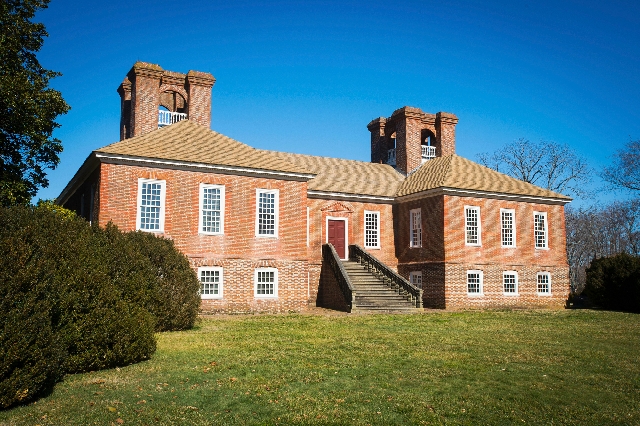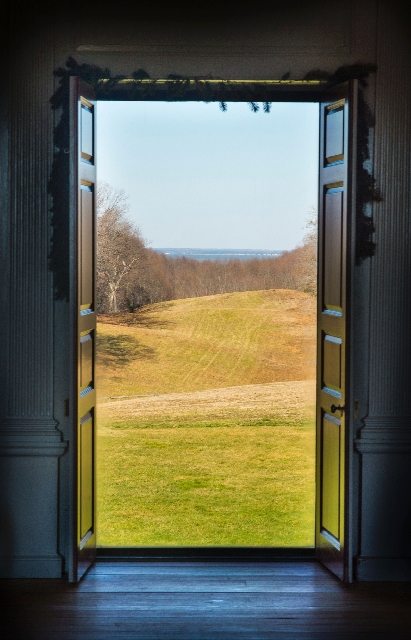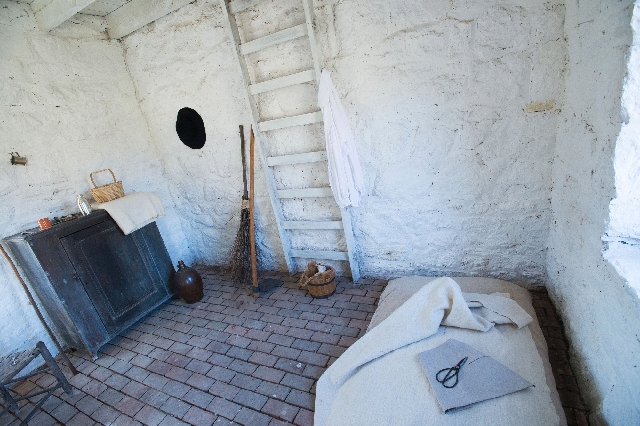Stratford Hall, birthplace of Robert E. Lee, alive with history
STRATFORD, Va.
The stately Virginia plantation home Stratford Hall is silent on a Sunday morning. Unless you are listening to the spirits of history.
It’s the history of Confederate general Robert E. Lee, who was born there, and of his distinguished ancestors, including the only pair of brothers to sign the Declaration of Independence, Richard Henry Lee and Francis Lightfoot Lee.
Marilyn Cottrell, a tour guide at the home for 31 years, can hear that history.
She can hear the clicking and clacking of spinning wheels and weaving looms as slaves and servants gathered to make fabric and to gossip.
In the library, she can hear the gathering of men convened to work on the Westmoreland Resolves, a protest against the English Stamp Act and one of the first acts of sedition by colonists. Light streams into the room from the pastoral setting in the Northern Neck of Virginia, which is bordered by the Potomac and Rappahannock rivers and the Chesapeake Bay.
In the schoolmaster’s room, a visitor can almost hear the Scottish lilt of the teacher and the scratch of chalk on slates.
Lee lived at Stratford Hall until only age 3 but kept the home dear, supposedly remembering the metal fireplace backstop in his nursery stamped with cherubs and the year 1745. As an adult, he mused wistfully about buying it back.
But Stratford Hall’s brush with history was much longer than the years Lee lived there. From the time his great-great-uncle Thomas Lee built the house, it was witness to history and home to generations of governors, legislators, revolutionary war leaders and diplomats.
“They were so instrumental in developing the country to what it is today,” said Cottrell, 79.
The Lees were one of the nation’s most significant families, said Emory M. Thomas, a retired University of Georgia history professor and a civil war scholar.
The public connects Lee with slavery, and slavery with racism. But Lee was so much more than that, says Thomas, author of “Robert E. Lee: A Biography.” He was an innovative educator as a college president, a talented military commander and someone who bounced back from numerous setbacks, including a bankrupt father and losing much of his own fortune in war bonds.
“Lee went to war because his friends and neighbors were under attack,” Thomas said. “He saw leaving the U.S. Army and joining the Confederate army as the natural thing to do, because to do otherwise would be to abandon friends and neighbors and family.”
A Stratford Hall visit helps “confront the complexity of Robert E. Lee,” Thomas added.
Visitors can tour the mansion as well as wander through the outbuildings and the plantation’s 1,900 acres.
A grist mill makes cornmeal that is sold in a gift shop on the premises.
The Great House itself has an expansive view of the Potomac, about a mile away over fields that once fueled the family’s wealth with tobacco crops.
The cliffs are made of compacted seabed from the Miocene era — one of only four such places in the world. Those soft white cliffs drop into the river where bald eagles wheel about, ducks paddle and Canada geese honk.
Visitors can enjoy a walk on the beach where fossils of sea creatures can be found. The grounds also include seven miles of hiking trails that traverse beautiful hardwood forests.
Also on the grounds is the Inn at Stratford Hall, which features guest houses and cabins tucked into the woods like an adult version of summer camp.
The grandiosity of the Great House and even the size of the visitor cabins stand in contrast to the cramped slave quarters on display. As the Revolution began, there were 84 slaves above the age of 12 at Stratford Hall, curator Gretchen Goodell Pendleton said. The fieldstone slave homes are reproductions and part of an effort to help visitors understand the plantation, which was in essence a black community, with slaves and servants outnumbering the Lees.
Slaves helped build the home, which took about seven years and used tulip poplars from the property and bricks made from local clay.
Cottrell estimates that the builders churned out about 119,000 bricks a year on-site to erect the home, which features a distinctive Flemish bond pattern of masonry and an H-shaped configuration. (No one knows the exact number of bricks, and even the house’s completion date of 1745 is an educated guess. We do know the house was under construction in 1739.) It is one of the most architecturally distinguished surviving homes built in the colonial period.
Stepping inside on a February day cold enough for snow, the welcome heat of the home immediately seeps into one’s bones. It’s the same sensation that visitors of the day would have had. The home was built with 16 fireplaces, on interior walls, making it one of the warmest homes in Virginia, Cottrell said.
Nowadays, the wave of warmth is intended to protect the period antiques (accurate for the family’s time but most not the original Lee family pieces).
The staff has paid great attention to detail with the interior. The paint colors were exhaustively researched, the dining room dessert service is laid out with forks turned down in the English style of the day, the boys’ bedroom has woolen socks left strewn on the floor as if left behind by the Lee children.
And there were plenty of children, many of whom went on to carve important places in American history. Thomas Lee had eight surviving children, including the pair who signed the Declaration of Independence. Mark Twain called them “a family which was able to shed as much honor upon official station as it received from it.”
It was Richard Henry Lee who made the motion in Congress to declare independence in 1776 and signed the declaration along with his brother Francis Lightfoot Lee. Their younger brothers, William and Arthur, were in Europe serving among the first American diplomats during the Revolutionary War.
Robert E. Lee’s father was Henry Lee III, known as “Light Horse Harry” for his cavalry skills. He was a second cousin and husband of Matilda Lee, who inherited the plantation. George Washington contributed the Madeira for their wedding at Stratford Hall, and soon Lee was elected governor of Virginia.
But Matilda died after eight years of marriage, and Lee remarried Ann Hill Carter. With her, he had five more children, including the boy who would go on to lead the Confederate army.
The room where Robert E. Lee was born in 1807 is part of the tour, with its wide planks of yellow heart pine flooring and red-and-cream bed and window dressings. The nursery also is on display, arrayed with a doll’s bed, a child’s tea set and tiny Windsor chairs.
Lee did not stay long enough to attend classes downstairs in the schoolmaster’s room. His father ran into financial troubles, and because the house had belonged to his first wife, it was inherited by “Light Horse Harry” Lee’s eldest son when he came of age.
Henry Lee IV was the last Lee family master of the plantation, and his life sounds much like a soap opera — with a morphine-addicted wife, a child killed in an accident and a scandalously pregnant sister-in-law.
After his marriage to Mary Custis, the great-granddaughter of Martha Washington, Robert E. Lee lived at the Custis plantation known as Arlington (now the home of Arlington National Cemetery).
Stratford Hall was converted into a memorial to the Lees in 1929.
But the Lees are certainly not the only historical figures from the area. James Madison, James Monroe and George Washington were born near Stratford Hall. The National Park Service runs the George Washington Birthplace National Monument, though the house is a re-creation built in 1931. The visitor center offers a film, exhibits and a gift shop with a lovely collection of children’s and adult books about the first president. And a farm offers glimpses of heritage breeds of animals.
Pendleton calls the area “a hotbed of independent thinkers” during the colonial era. “You see the ebbs and flows of national and Virginia history in one location. It’s not just a one-person story.”
IF YOU GO
Destination: Stratford Hall is located in Westmoreland County, Va., about 45 minutes east of Fredericksburg, Va., and two hours from Washington. 483 Great House Road, Stratford. 804-493-8038. A list of special events such as wine dinners and holiday events is available at stratfordhall.org. The National Historic Landmark estate is open on weekends during the winter and daily the rest of the year, from 9:30 a.m. to 5 p.m. Tours run every hour from 10 a.m. to 4 p.m.
Lodging: The Inn at Stratford Hall has 21 rooms in two lodges for $120 a night. Some cabins, with varied prices, also are available at times at the plantation. For more information, go to stratfordhall.org. The Inn at Montross, 21 Polk St., Montross, Va., is a recently renovated bed-and-breakfast, theinnatmontross.com, 804-493-8624. Nearby Colonial Beach also has cottages available, colonialbeachcottages.net, 804-333-1919. Westmoreland State Park has campsites and cabins, virginiastateparks.gov, 800-933-7275. For luxury, the Tides Inn, is a bit farther away in Irvington and has a golf course, spa and marina, 480 King Carter Drive, tidesinn.com, 800-843-3746. Also in Irvington is the Hope and Glory Inn in a historic schoolhouse, hopeandglory.com, 800-497-8228.
Dining: The Inn at Stratford Hall’s dining room is open year-round for lunch, and for dinners Thursdays through Saturdays. Specialties include crab cakes and ginger cookies. The Art of Coffee offers several egg dishes and tasty sandwiches for breakfast and dinner, 15722 Kings Highway, Montross, 804-493-9651.



















